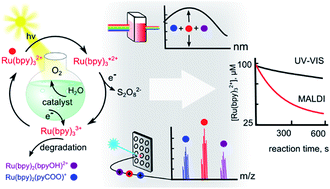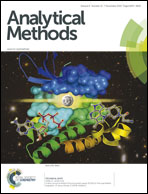Quantitative determination of the Ru(bpy)32+ cation in photochemical reactions by matrix-assisted laser desorption/ionization time-of-flight mass spectrometry†
Abstract
The coordination compound of Ru(II) with three 2,2′-bipyridine ligands possesses a potent photosensitization capacity for electron- and energy-transfer processes. In combination with salts of peroxydisulfate acid as sacrificial electron acceptors, Ru(bpy)32+ is widely used for photocatalytic oxidative transformations in organic synthesis and water splitting. The drawback of this system is that bipyridine degrades under the resulting strongly oxidative conditions, the concentration of Ru(bpy)32+ diminishes, and the photocatalytic reaction eventually stops. A commonly employed assay for the determination of Ru(bpy)32+, UV-Vis spectroscopy, has low selectivity and does not distinguish between the intact complex and its decayed forms. Here, we report a matrix assisted laser desorption/ionisation mass spectrometric method for the quantitative analysis of Ru(bpy)32+ in photochemical reaction mixtures. The developed method was successfully used for the determination of intact Ru(bpy)32+ during the course of the water photooxidation reaction. The significant difference between the results of MALDI MS and UV-Vis analyses was observed.



 Please wait while we load your content...
Please wait while we load your content...